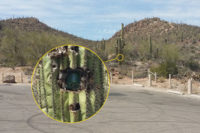First of all, it is better to hard-wire security video, especially when it comes to megapixel cameras.
But there are times, locations and missions where wireless makes the best sense.
Scott King has figured out a way to mix and match wired and wireless.
As the lieutenant for the Pittsboro, Ind., police department, he operates a city surveillance project that uses technology to help monitor potential problem areas including a public park. “We have seven cameras in the park area. Six are wired and one is wireless,” King says. The wireless unit is in a park shelter location where wireless works better. “We worked with Avigilon on converting six existing analog cameras to digital output with encoders and set up the wireless camera.”
While not constantly monitored, the cameras’ output is recorded and live, and recorded images can be viewed through a laptop or on a smartphone. The design has “already helped us solve two crimes in addition to the deterrence effect,” points out King.
A more extensive wireless installation is used by the city of Freeport, Texas, which had ADT Integrated Solutions provide and install a wireless video surveillance system to help reduce crime in a public housing project and a marina. Among phases to help protect critical infrastructure in one of the nation’s largest ports and home to the fourth largest oil reserve and 29 chemical companies, the city uses a wireless mesh network to transmit video from IP-based cameras located throughout the city to be recorded in the city hall and monitored 24/7 in the nearby Freeport Police Department headquarters.
A Logistics Challenge Solved
Ty Morrow, chief of police for Freeport, points out that “Freeport is basically an island that is home to assets of critical importance to the nation’s economy. This wireless video surveillance system will help us do our job of providing public safety by adding extra ‘eyes’ in the field.”
The city decided on a wireless network system because it was logistically difficult and expensive to run fiber to all the areas that needed to be under surveillance. The geographical layout of Freeport, as a port town on the coast, doesn’t have fiber running throughout the city and it doesn’t have access to fiber or T1 lines, so the next best solution was to design a wireless solution.
But in Orlando, Fla., which has a lot of city fiber installed primarily by the traffic department, wireless mesh fills the “fiber gap.” One wireless example is at Lake Eola, a city park in the downtown area. The head-end mesh node is connected to city fiber, which backhauls video to the police monitoring center. This mesh node, with its two antennas – one per radio, aggregates the wireless video traffic from camera/mesh node locations around the lake.
Wireless video technology has matured.
But it may prove challenging when working with higher resolution video and more demanding video applications such as license plate recognition, facial recognition or thermal analysis. Still, as enterprise security leaders move to using IP-based surveillance cameras, the use of industrial wireless Ethernet is a more natural fit.
Aiming at Mobility
There are also an increasing number of wireless video uses, such as wireless video on trains, subways and other mass transit situations.
And wireless video can integrate with wireless access control systems.
For example, Phoenix-based Dolphin Precision Investment Castings, with a 13-acre, multi-building campus, has a campus-wide security system that covers everything from access control to perimeter detection with software and remote monitoring needs. Says Kris Richins, facilities manager and engineer for Dolphin, the company canceled a physical on-site security officer contract in favor of the multi-faceted security system, which includes 16 cameras and a DVR at its core. It added MobileCamViewer for remote monitoring during non-business hours to further reduce costs and expedite return on investment.
The design “allows us to remotely check our cameras over our iPhones and Androids when we are contacted by the alarm company,” says Richins. “We can immediately confirm if there is enough evidence to call the police without having to be near a computer with an Internet connection. With an average distance of 18 miles from our homes to the campus, we are also eliminating many back and forth trips for no reason.”
Richins adds that their fixed cameras are positioned indoors and outdoors, focused on employee turnstiles, lobbies, loading docks, parking lots and general building perimeters. This allows them to get a view of everything that is happening throughout the most heavily trafficked campus areas, including breezeways between buildings.
Remote Look-in Capability
“Mobile surveillance is very valuable in a campus setting with a lot of exposed areas in and around the buildings,” says Richins. “The cameras themselves offer a visual deterrent, but the signage that points to around-the-clock monitoring through remote surveillance goes a long way. I think it’s a very critical component of modern security systems.”
Another twist on wireless: Talk-A-Phone has designed a wireless version of its Eco Tower emergency phone tower, which also supports solar and day-night switching power configurations. The tower can be deployed in remote areas with a cellular or VoIP wireless interface.
This article was originally published in the print magazine as "Wired or Wireless? Video Picture Diversifies."
See More with Less
In addition to options in transmitting security video, there also are increased ways to cost effectively bring more video data to enterprise security leaders, sometimes with unique cameras that can capture more view. For example, Salient Systems has integrated Scallop Imaging cameras with its video management system platform. The camera generates seven megapixel resolution across a panoramic, 180 degree field of view, with H.264 compression and Power over Ethernet.






